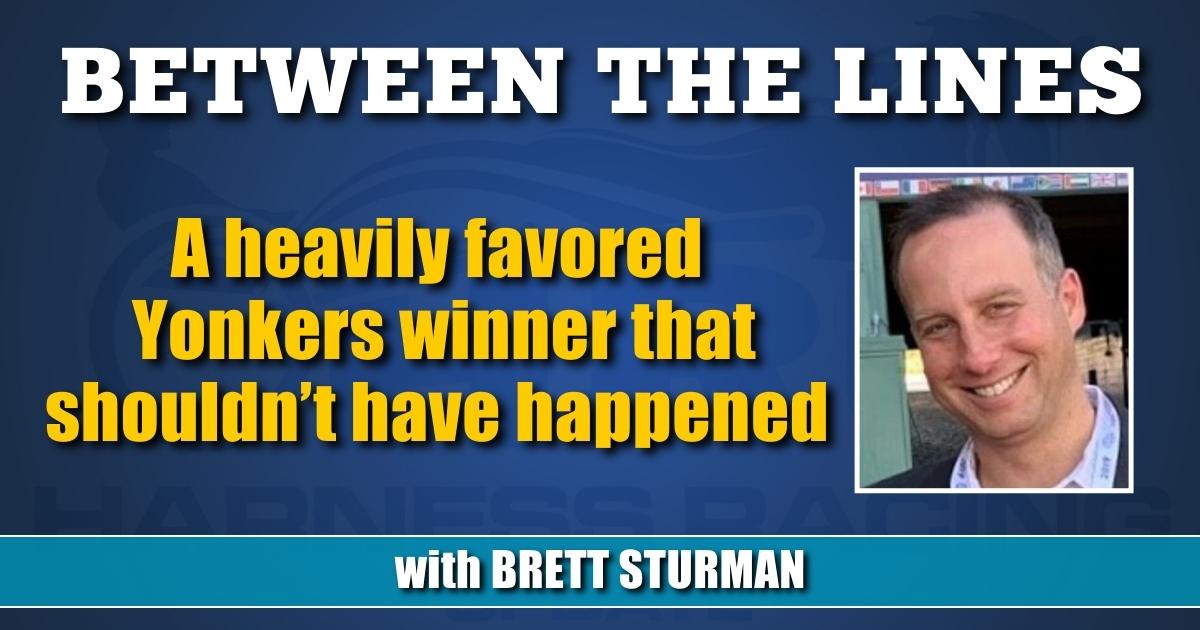

A heavily favored Yonkers winner that shouldn’t have happened
by Brett Sturman
This past Monday, a short-priced horse won the third race at Yonkers and paid the minimum $2.10 across the board for his efforts. There’s nothing noteworthy about that alone, until you look at the circumstances for how this horse in the race came to be.
The sport’s co-fastest horse this year with a mark of 1:48.3, a winner of two Meadowlands opens as well as a Yonkers open just this year alone so far, Nandolo, was afforded a massive — and what I’ll argue unnecessary — drop in class into a mid-level conditioned race. Perhaps a touch outmatched but generally an upper level to open-caliber horse at Yonkers, Nandolo had competed well enough throughout the FFA Borgata Pacing Series, including a loss by just a couple of lengths in the $100,000 consolation the week prior to this one.
With his card showing earnings of $15,000 through his last five starts, Nandolo was able to drop into a condition where it would have been near impossible for him to lose and the odds in that race reflected as such, where he was made the 1-20 favorite at 5 cents on the dollar. For many reasons Nandolo should have never been in this race.
To start with, Nandolo wouldn’t have even qualified as the race was originally written. Being right at $15,000 earned in his last 5 starts, Nandolo wouldn’t have been eligible for the condition of non-winners of $15,000 in his last 5 since he earned that right on the dot, so the condition was changed to non-winners of $15,001 in the last 5.
Of course, all the time conditions are changed by a few dollars similar to this to allow for more full fields, but it’s rare when doing so would produce such an overwhelming favorite. From the perspective of the racing secretary, wouldn’t writing in a 1-20 favorite go against everything that the position is trying to accomplish in terms of creating evenly-matched fields? At the absolute least, why wasn’t there an added stipulation that Yonkers does throughout other races that could have been something to the effect of winners of $15,000 or more in their last 5 draws outside? That there was such a desire to adjust the condition by a dollar to fit in a horse like Nandolo into that spot is simply poor form.
Let’s take it a step further. For argument’s sake, what if Nandolo had met the original condition as it was first defined. Even then, there were still better options that the race secretary would have had to both maximize field size and optimize handle for the track that night.
Despite a full field of eight horses, the race with Nandolo had the third lowest win pool that night. The only two races that had lower win pools were two separate five-horse races. One of those races was a non-winners of $30,001 L5 condition, a race that came immediately before the Nandolo race. If you were a race secretary trying to create races that would collectively generate as much handle as possible, why wouldn’t Nandolo go into that race instead? It’s a race where, depending on post position, Nandolo would have been favored and could have won. And in doing so, you’d be taking a five-horse field to a more reasonable number of six, while at the same time opening up another race to be entirely more competitive. As it was, the total win pool between those two races was about $18,500. In the hypothetical but easily doable condition just described, the total win pools would have been over $30,000. Yet another option would have been to use Nandolo to complete the first race of that same night, which went to post with only seven horses in a non-winners of $20,000 L5 race. It’s the race that he should have gone into based on paper and would have been favored in that race as well.
With rare exception, I do think that if a horse meets a condition on the merits, then they should be able to race there. But again, it then comes back to being able to write conditions that produce evenly matched fields. At The Meadowlands for example, it’s written that even if certain earnings conditions are met, that a horse still cannot race if he had been racing in a superior class prior. A similar condition would have prevented an open-type horse racing against horses with non-winners of $5,000 and non-winners of $7,500 lines.
Better judgement needs to be used, especially on smaller-sized tracks that already produce a high percentage of shorter-priced winners. Obviously, the goal is at the same time to produce full fields and competitive fields. This leads to less predictable racing, higher payouts and certainly an increased volume in wagering.
Some heavy favorites are largely unavoidable. In series or stakes races, or in a maiden or a non-winners of 2 races there isn’t much that can be done but seeing a 1-20 favorite in a mid-level conditioned race on a Monday indicates that something has gone wrong. In creating full and competitive fields, it not only benefits horseplayers but it also benefits horsepeople as well. For the connections of all horses other than Nandolo from the race in question, what would have been a purse of $21,000 to race for, amounted to $10,500 after half of it had essentially been gifted away.
To be fair, this is far from the first instance throughout the industry of egregiously adjusting a condition to allow what subsequently becomes a heavily favored horse to enter a race, but it doesn’t make the practice of it right. The overriding goal must be to put forth the highest possible quality product.














